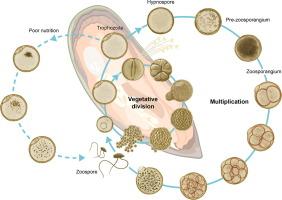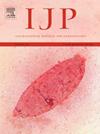Isolation, culture, and optimal growth conditions for the shellfish protozoan parasite, Perkinsus olseni
IF 3.2
2区 医学
Q1 PARASITOLOGY
引用次数: 0
Abstract
Aquatic parasite cultures are a significant asset to improve our understanding of organism biology, transmission and disease progression, and evaluation of preventative and treatment measures. We adapted and optimized international standard methods for the isolation and culture of Perkinsus spp. for Perkinsus olseni. Perkinsus olseni cells were isolated from green-lipped mussels, Perna canaliculus, in Ray’s fluid thioglycollate medium with incorporated antibiotics and grown in Dulbecco’s Modified Eagle Medium-Ham’s F-12 culture medium. Sequencing of the internal transcribed spacer region confirmed the culture was consistent with that previously reported for P. olseni (100% homology). Parasite morphology and life cycle stages were described and consistent with known stages of trophozoites, hypnospore, and zoosporangia and zoospores. A suspected additional reproductive mode which commonly occurred under poor nutritional conditions was comprised of trophozoite-like cells which developed into small motile zoospore-like cells. Mussel hemolymph supplement resulted in the rapid development of pre-zoosporangia into zoosporangia and the release of motile zoospores. Temperature had a significant effect on parasite propagation, which increased significantly above 20 °C and reached an optimum at 22 °C. At 35 °C Perkinsus proliferation was strongly reduced, suggesting that the upper thermal limit of P. olseni is 30 °C < T ≤ 35 °C. Cryopreserved cells recovered well under normal culture conditions. The optimised methods for the isolation and culture of P. olseni provide the foundation for subsequent in vivo and in vitro experimentation, and can advance our knowledge and management of this globally significant shellfish disease.

贝类原生动物寄生虫奥氏波金索的分离、培养和最佳生长条件。
水生寄生虫培养是提高我们对生物生物学,传播和疾病进展以及预防和治疗措施评估的重要资产。本实验采用国际标准方法对珀金苏氏菌的分离培养进行了优化。从绿唇贻贝(Perna canaliculus)中分离出珀金苏斯(Perkinsus olseni)细胞,将其放入含有抗生素的Ray's液体硫代乙酸盐培养基中,并在Dulbecco's Modified Eagle medium - ham 's F-12培养基中培养。内部转录间隔区测序证实培养与先前报道的P. olseni一致(100%同源性)。描述了寄生虫的形态和生命周期阶段,并与已知的滋养体、催眠孢子、游动孢子和游动孢子的阶段一致。一种在营养不良条件下常见的附加生殖模式是由滋养体样细胞发育成小的游动孢子样细胞。贻贝血淋巴的补充使前游动孢子囊迅速发育为游动孢子囊,并释放出游动孢子。温度对寄生虫繁殖有显著影响,在20℃以上显著增加,在22℃时达到最佳。在35℃时,Perkinsus的增殖明显减少,说明P. olseni的热上限为30℃< T≤35℃。低温保存的细胞在正常培养条件下恢复良好。优化的分离和培养方法为后续的体内和体外实验提供了基础,并可以提高我们对这种全球重要贝类疾病的认识和管理。
本文章由计算机程序翻译,如有差异,请以英文原文为准。
求助全文
约1分钟内获得全文
求助全文
来源期刊
CiteScore
8.40
自引率
2.50%
发文量
76
审稿时长
23 days
期刊介绍:
International Journal for Parasitology offers authors the option to sponsor nonsubscriber access to their articles on Elsevier electronic publishing platforms. For more information please view our Sponsored Articles page. The International Journal for Parasitology publishes the results of original research in all aspects of basic and applied parasitology, including all the fields covered by its Specialist Editors, and ranging from parasites and host-parasite relationships of intrinsic biological interest to those of social and economic importance in human and veterinary medicine and agriculture.

 求助内容:
求助内容: 应助结果提醒方式:
应助结果提醒方式:


